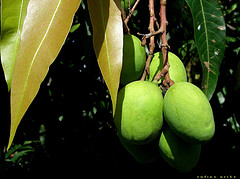Mangoes
| Infobox on Mangoes | |
|---|---|
| Example of Mangoes |  |
| Freshness facts | |
| Optimum carrying temperature | 10°C to 12°C |
| Highest freezing point | -1°C |
| Acceptable product temp. at loading into containers | Max. 2°C above carrying temperature |
| Optimum humidity | 85%-90% |
| Ventilation setting for containers | 25 m³/hr |
| Storage life | 2-3 weeks |
| Climacteric / non-climacteric | Climacteric |
| Ethylene production | Moderate |
| Ethylene sensitivity | High |
| Modified / controlled atmosphere | 5%-8% CO2; 3%-7% O2 |
| Potential benefits | Low O2 can delay ripening Elevated CO2 maintains firmness |
| Availability | |
| Australia South Africa South America Central America |
November - January January - May September - March January - October |
Mangoes
Contents
Harvesting and handling
There are many different varieties of mangoes, meaning that they vary greatly in shape, colour, size and weight. A mango may be oval, roundish, elongated or kidney-shaped; it may be green, green-yellow or even orange to red in colour. The length of the mango is up to 25 cm, its maximum width 10 cm. The heaviest mangoes weigh up to 2 kg.
The delicious yellow to orange coloured flesh, which constitutes 60 - 70% of the fruit, is located under the thin, inedible outer skin. Fibres join the flesh to the large, egg-shaped white stone inside, so explaining the difficulty of removing the stone from the flesh.
Mangoes are harvested when unripe (at the pre-climacteric); they must still be green and firm-fleshed. Harvesting is done by hand or using special fruit picking poles. The greatest possible care must be taken with harvesting as even the smallest of cracks results in rapid spoilage by rotting.
At the time of harvest, the mangoes must be capable of post-ripening, as they will otherwise not reach optimum quality. Post-ripening may be accelerated by temperatures of 25 - 30°C and treatment with ethylene.
Once harvested, any exuding latex is cleaned off and the mango is treated with hot water and fungicides in order to extend the relatively short storage life.
The following are the main varieties for export:
"Kent" "Tommy Atkins" "Haden" "Keitt"
Mangoes are highly pressure- and impact-sensitive and appropriate care must therefore be taken during cargo handling.
Skin colouration, size, shape for variety, appearance, freedom from defects and decay, absence of fibre in the flesh and turpentine-like flavours are the most common quality parameters. Wilted, greyish discolouration and pitting are undesirable. Some fruit varieties (Haden) have pinhead-size black spotting that is not regarded as a defect.
Cooling and storage
Mangoes are living organs in which respiration processes predominate, because their supply of new nutrients has been cut off by separation from the parent plant.
Care of the cargo during the voyage must be aimed at controlling respiration processes (release of CO2, water vapour, ethylene and heat) in such a way that the cargo is at the desired stage of ripeness on reaching its destination. Inadequate ventilation may result in fermentation and rotting of the cargo as a result of increased CO2 levels and inadequate supply of atmospheric oxygen.
Mangoes show a climacteric pattern of respiration and, during ripening, the flesh becomes soft and juicy with a rich flavour and aromatic fragrance. The onset of ripening is accompanied by a five-fold increase in heat production.
In view of this substantial increase in heat production which accompanies the onset of ripening (before any visual change is apparent), it is essential that fruit for overseas shipment be cooled as soon as possible, preferably within 24 hours of harvest. If more than a small proportion of mangoes has entered the climacteric stage by the time of loading into refrigerated space, there is a risk that heat production by the mangoes may impose too great a burden on the cooling cycles. If this happens, more and more fruit is triggered into ripening in an atmosphere depleted of oxygen and rich in carbon dioxide and ethylene; the temperature rises further and ripening proceeds in abnormal fashion.
Storage at 10°C to 12°C with 85% to 90% RH, should give a shelf-life of 2-4 weeks for mature green fruit, depending upon variety. Chilling susceptibility varies with cultivar; Haden and Keitt are particularly susceptible. Most cultivars show injury below 10°C, especially if fruit have just reached maturity. Tolerance to chilling injury increases during ripening. Ripe fruit can be stored at 7°C to 8°C.
Symptoms of chilling injury include uneven ripening, poor colour and flavour, surface pitting, greyish scald-like skin discoloration, increased susceptibility to decay, and, in severe cases, flesh browning. Chilling injury incidence and severity depend on cultivar, ripeness stage (riper mangoes are less susceptible) and temperature and duration of exposure.
Mixed loads
Do not ship with ethylene-producing commodities
Cautions
O2 below 2% for longer than two weeks can cause off-flavours and skin discoloration. CO2 above 10% can cause softening, off-flavours and greyish flesh colour.
Storage disorders
Alternaria black spot, Anthracnose, Bacterial black spot, Bacterial rot, Black mould rot, Chilling injury, Internal breakdown, Powdery mildew, Soft nose, Stem end breakdown, Stem end rot.











